A Brightline train runs through North Miami on Friday, June 27, 2025. Matias J. Ocner mocner@miamiherald.com
By Brittany Wallman, Aaron Leibowitz, Shradha Dinesh, Susan Merriam, Daniel Rivero and Joshua Ceballos
Updated July 15, 2025 12:03 PM
On a steamy summer afternoon in 2017, workers at an office along the railroad tracks in Boca Raton waited for a glimpse of the new Brightline train as it flashed by on a test run.
Shonda Bambace, an insurance agent, heard the whistle and rushed to see the sleek, yellow passenger train that would roar through South Florida at high speeds.
And then she saw the girl.
A young woman with blonde hair was walking toward the tracks. Bambace heard a thud. The train streaked by — and the girl was gone.
Bambace tried to yell out, but the words wouldn’t come. The girl resembled her own daughter. The blonde hair. The denim shorts. The T-shirt. All familiar.
“Hit by the train!” she finally screamed. “Hit by the train!”
Bambace had just witnessed Brightline’s first fatality. Madison “Maddie” Brunelle, 18, who was bipolar and in a manic state, had just walked out of a treatment facility when she turned toward the tracks.
“I remember it like it was yesterday,” said Bambace. “I still have dreams about her.”
Since then, the death toll has climbed at an extraordinary rate. Brightline trains have killed 182 people, significantly more than publicly known, an investigation by the Miami Herald and WLRN, South Florida’s NPR member station, has found. Reporters spent a year combing federal rail data, local medical examiner records and police incident reports to count the dead. Brightline officials did not dispute the finding.
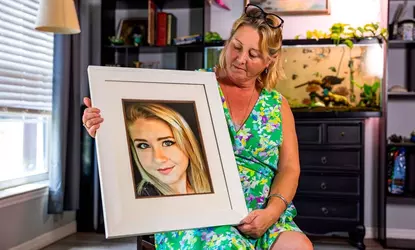
Amy Brunelle holds a photo of her daughter, Madison, at her Fort Pierce home in April. ‘Maddie,’ 18, was the first person struck and killed by a Brightline train. Her death was ruled a suicide. Her mother says that every time she sees the Brightline, she wonders, ‘Is that the train that hit my daughter?’ Matias J. Ocner mocner@miamiherald.com
The reporting team found that Brightline has failed to urgently address the train’s dangers, blamed victims for the high death rate, and, as fatalities climbed, turned to the public to pay for safety upgrades. Even then, critical life-saving measures, including fencing along the tracks and suicide-crisis signs, haven’t been installed due to years-long delays in the release of federal funds.
Local governments and regulators have added to the problem. Deaths have spiked in parts of South Florida where train horns were intentionally silenced after cities and counties demanded “quiet zones” so as not to bother people living near the tracks. But federal regulators have allowed the train-horn bans to stay in place, and cities have resisted closing treacherous railroad crossings.
Brightline is the nation’s most dangerous passenger train, reporters found, killing someone every 13 days of service, on average. In addition to those deaths, 99 people have been injured. In at least 101 cases, the train crashed into vehicles, but no one was hurt.
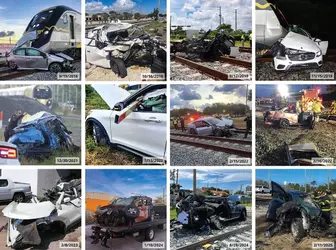
Brightline trains have hit vehicles at least 167 times since starting operations in 2018; 21 of those crashes killed people. Image credits: Hallandale Beach Fire Rescue, Pompano Beach Rescue, Broward Sheriff’s Office, Miami-Dade Sheriff’s Office, Joe Cavaretta for the South Florida Sun Sentinel, Miami Fire Rescue, Delray Beach Fire Rescue, Palm Beach County Fire Rescue, National Transportation Safety Board, Melbourne Mayor Paul Alfrey’s Facebook, Broward Sheriff’s Office, Malabar Fire Department
The company has not been found at fault for any of the deaths on its tracks. It has faced at least a dozen lawsuits for deaths and injuries, according to court records. None have gone to trial. Some have been settled for undisclosed amounts.
In a written statement, Michael Lefevre, Brightline’s vice president of operations, reiterated what the company has been saying for years — that the deaths were self-inflicted.
“These incidents are tragic and avoidable. More than half have been confirmed or suspected suicide — intentional acts of self-harm. All have been the result of illegal, deliberate and oftentimes reckless behavior by people putting themselves in harm’s way.”
Lefevre said their actions “impact our guests who count on Brightline to get them to work, the theme parks, or special events.”
Brightline officials say the company has gone to great lengths to warn the public about the dangers of the train and has pushed for stricter enforcement against trespassers and motorists who maneuver around gates. The company has been “a leader in the industry on safety initiatives related to education, enforcement and engineering,” Lefevre said.
The initiatives didn’t work. Last year, after Brightline extended service through the Treasure Coast to Orlando, 49 people died by the train, the highest number yet. Most of the deaths — 34 of the 49 — occurred in Palm Beach, Broward and Miami-Dade counties.
Contrary to the company’s messaging, the majority of deaths were not ruled suicides. Brightline reviews crash footage and adds “suspected” suicides to its statistics, based in part on whether a person tried to get out of the way. But reporters reviewed autopsy rulings for each case and found the majority of the fatalities were accidents or undetermined. Of the 182 dead, 75 were ruled suicide by local medical examiners — or about 41%. In Broward County, where 61 people have died, 30% were ruled suicide.
Ninety-one deaths were ruled accidental. Ten were undetermined, and the remaining six rulings are pending.
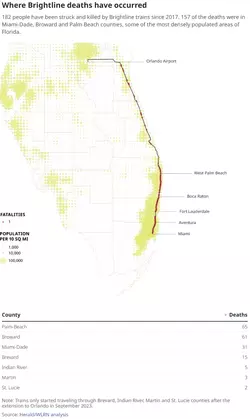
Before Brightline began commercial service in 2018 as the country’s only private passenger railroad, lawmakers and regulators at the local, state and federal levels sounded the alarm about the risks of running a fast passenger train through one of the most densely populated corridors in Florida. But they ultimately let the project move forward with insufficient safeguards.
As the death toll climbed, millions of taxpayer dollars started flowing to protect the public from Brightline accidents. Lefevre said Brightline has spent “hundreds of millions of dollars” on safety improvements, even as the company argues that the dead are at fault.
That argument has won traction on social media. On one popular Instagram account that tracks Brightline deaths, victims are frequently mocked and derided. “The Darwinism Express doing the Universe’s work,” someone commented after a Brightline crash in June. “I’m sorry, but if you get hit by a train, you deserve it,” read a comment after another death in May.
One website attempts to keep a running tally of those “the train hath slain.” Elsewhere, Brightline is sardonically dubbed “Frightline” or “Flatline.”

On social media, comments pour in when a Brightline train strikes and kills someone. This Instagram post from the account brightlinecrashtracker on June 13 shows how Brightline deaths are fodder for jokes.
Public attention is attracted to spectacular crashes — such as the one that ended 46-year-old Clivet Romero’s life. He zigged and zagged his Maserati around cars stopped at the tracks in Oakland Park and sped around a gate. The Brightline impact flung his body into a flashing light signal, and he was sliced in half. His car exploded into a fireball.
But drivers account for relatively few of the fatalities. The Herald/WLRN found that only 24 people — or 13% — were in cars.
Pedestrians are most at risk. The luxury-priced train runs through urban centers, bar districts and neighborhoods. Of the 182 dead, 158 were on foot or bicycle, reporters found.
About 60% of those who died weren’t at crossings, according to federal data. Many didn’t navigate around downed gates or see lights flashing. Official report after report recounts people noticing the Brightline moments before it killed them.
182
Number of people killed by Brightline trains from 2017 - 2025
The dead include a woman who fled Ukraine with her husband and young children in 2022 after Russia invaded. Two months into her new Miami life, her last moment was to turn and look in shock at a Brightline train.
Another woman forgot something and ran to retrieve it. On the way to rejoin her group, she tripped on the tracks in the dark. The medical examiner’s report says the train engineer saw “the light of her cell phone tumble forward” as it flew out of her hands, just before she was struck.
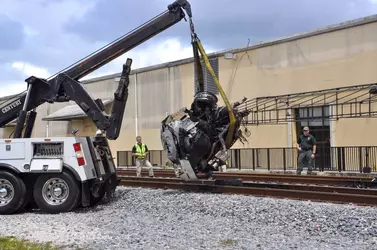
A crane removes a crushed Maserati from the railroad tracks in Oakland Park after Clivet Romero, 46, was killed in a fiery Brightline crash in September 2019. Romero saw a slow-moving freight train and drove around the gates to try to beat it. A police report said Romero was ‘oblivious’ to the fact that a much faster Brightline train was approaching from the other direction. Broward Sheriff's Office
The most dangerous train
Brightline remains the deadliest major passenger railroad in the United States, according to a Herald/WLRN analysis of data since 2018 from the Federal Railroad Administration.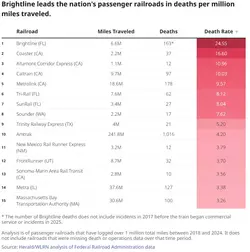
Trains that travel above 125 mph are subject to mandatory safeguards, requiring that the tracks be separated from roads and have no traffic crossings. By keeping its speeds under 125 mph along most of the route, Brightline is allowed to run at street level without fencing or separation from pedestrians and cars.
The trains reach 79 mph between Miami and West Palm Beach, and 110 mph farther north to Cocoa. Only the final segment to Orlando, which opened in 2023, travels at speeds up to 125 mph. It is fenced off and inaccessible to cars and pedestrians. No one has died there.
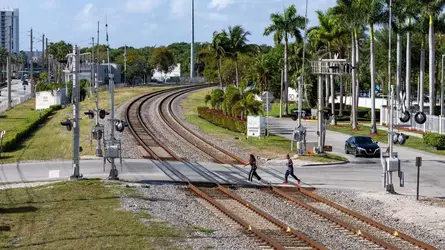
People walk across train tracks that intersect Northeast 141st Street near Biscayne Boulevard in North Miami. Brightline trains run almost entirely at street level through hundreds of crossings between Miami and Cocoa. Matias J. Ocner
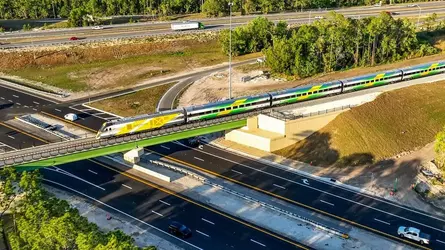
A Brightline train crosses a bridge in Central Florida along State Road 528. The 35-mile stretch between Cocoa and Orlando is “grade separated” without street-level crossings. Courtesy: Brightline
Brightline faces more danger zones than other passenger trains that travel at similar speeds, an analysis of federal rail data found.
The Florida train runs almost entirely at street level, traverses crossings at high speeds, doesn’t sound its horn along much of the route and cuts repeatedly through high-volume intersections.
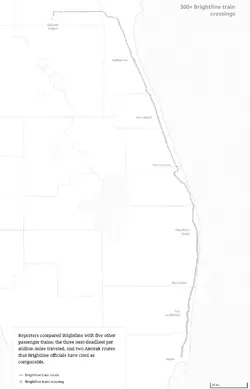

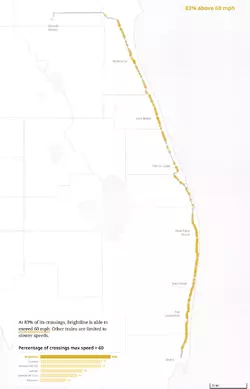
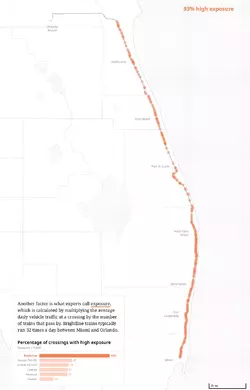
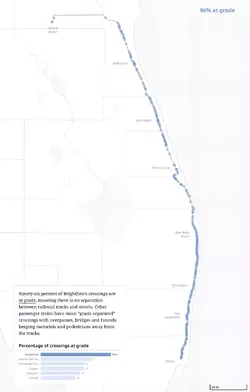
Ian Savage, a rail-safety expert at Northwestern University, said Brightline’s location makes the train more dangerous. Brightline shares its tracks with freight trains on the Florida East Coast Railway, feet away from major highways such as U.S. 1.
“If you were building this from scratch,” Savage said, “you would never do this.”

Emergency:
Introducing Killer Train:
Introducing Killer Train:
‘Stop victim blaming’
In South Florida, where most of the dead were struck, slow freight trains and fast Brightline trains come and go on two parallel tracks, sometimes from opposite directions.In Brightline’s first week of service, the train struck and killed a man on a bicycle. Jeffrey King, 51, was pedaling home from work at Troy’s Barbecue and tried to beat the train on Ocean Avenue in Boynton Beach.
A video from the front of the train showed King looking straight ahead, unaware of what was coming.
King’s was the fourth Brightline death. Members of Congress demanded answers. Marco Rubio, then a U.S. senator, called for a federal review of the train’s safety record.
U.S. Rep. Brian Mast, R-Fort Pierce, rejected Brightline’s public comments that people like King should simply heed safety warnings at the crossings.
“Stop victim blaming and take responsibility for the fact that your trains are killing people,” Mast tweeted at the time, sharing a story about King’s death. “Trains should stop running until massive safety flaws are resolved.”
The company’s president, Patrick Goddard, told a congressional committee in April 2018 that those claiming the train was unsafe “choose to ignore the facts and the actual police reports surrounding these incidents, a common theme of bending information to suit their anti-progress narrative.”
“Every person who has died on our railroad has either chosen to end their lives or been under the influence of drugs,” he said.
Two of the six deaths by then were ruled suicides. The rest of the victims tested positive for drugs, but it’s unclear whether that played any role in their deaths. King had marijuana in his system, but the Palm Beach County medical examiner’s office told the Herald/WLRN team that it’s impossible to know whether he was impaired, based on his toxicology results.
In public statements, the company has combined suicides and cases where a person had drugs in their system, claiming in 2020 that 75% of deaths were “the results of suicide or drugs.”
The suggestion that most Brightline fatalities were self-inflicted baffles the brother of Randy Johanson, a 62-year-old whose gruesome death last year occurred at the Barefoot Boulevard railroad crossing in Micco, north of Vero Beach.
Johanson was having a typical day. He walked to the Winn-Dixie liquor store, bought a few tiny, black-cherry-infused whiskey bottles and headed toward home.
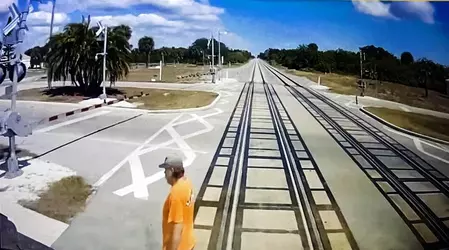
This still image taken from a Brightline train cam shows Randy Johanson, 62, shortly before the train struck him on April 18, 2024. He had made it across the tracks, but trains are wider than the rails by about three feet on each side. Brevard County Sheriff’s Office
It wasn’t far. But he would have to cross the tracks, and a train he had never heard of was whizzing along at 102 miles an hour.
Johanson was deaf — he had measles as a child. At home beside his bed, he had left his hearing aids. His uneaten lunch, ramen noodles, sat on the counter.
He walked past the warning gate and was just across the tracks when the train hit him, video shows. Trains extend beyond the track about three feet on each side, and a second or two would have made a difference. The engineer noted Johanson “was kind of like shuffling, and didn’t look up at us.”
Johanson’s brother, Daniel, a retired Lockheed Martin engineer, choked up during an interview at his Melbourne home in March as he cut into a sealed brown envelope marked as biohazard. He had been holding onto it for a year, avoiding it. He used the scissors as tongs, pulling out his brother’s blood-spattered ID cards and wallet. Remembering how the train “decimated” his brother’s body, he said he just doesn’t understand.

Daniel Johanson, a retired engineer, cuts open an envelope containing his brother Randy's wallet, found at the scene where he was struck by a Brightline train. 'I haven't had the heart to open it yet,' he said. Brittany Wallman bwallman@miamiherald.com
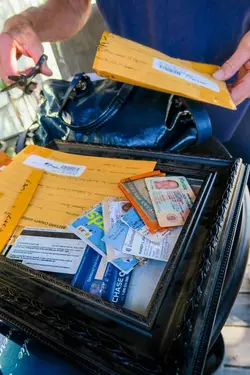
Randy Johanson, 62, was struck and killed last year at the Barefoot Boulevard railroad crossing in Micco. His body was 'launched 15 feet into the air,' and struck a pole, the medical examiner's report says. Brittany Wallman bwallman@miamiherald.com
“My thought, being an engineer,” he said, “is that you pre-plan your projects, and you consider all those safety issues … before you start running a train at 110 miles an hour through small towns where people aren’t even aware of what’s going on.”
Randy Johanson’s death initially was ruled a suicide by the Brevard County Medical Examiner’s Office, then changed to “undetermined.” Daniel Johanson said his brother loved fishing and watching reruns of “M*A*S*H.” Randy’s death was not a suicide, he said.
“I think it’s a travesty that they would even make that supposition, you know, without any evidence to support that,” he said.
‘Never looked up’
Danny Black, a photographer, was crossing the tracks in North Miami in the fall of 2023 when he was hit by a Brightline train.The train conductor told police that Black, 55, was wearing headphones and “never looked up or seemed to know that the train was approaching.”
Black’s home was a few blocks away. He was walking east, to an area with restaurants and a Publix. He had taken up jogging to lose weight. He loved NASCAR. He was “a wonderful man,” his sister Jody McDonald said, crying, in an interview at her Canaveral Groves home in March.
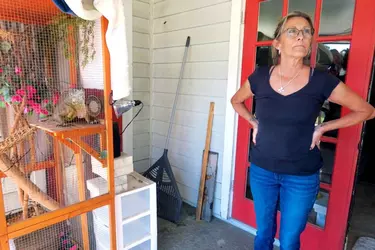
Jody McDonald’s brother, Danny Black, 55, was wearing headphones when a Brightline train struck and killed him in North Miami on Nov. 11, 2023. McDonald spoke to reporters in her Canaveral Groves home in Brevard County. ‘I’ve heard about the accidents and they just keep happening,’ she said. ‘Makes you wonder what precautions they’re taking. What are they doing different?’ Brittany Wallman bwallman@miamiherald.com
A neighborhood road abuts the tracks, and a path through the grass shows Black wasn’t the first to trespass in a location where there was no official crossing.
Brightline’s tracks run near schools, parks and neighborhoods. Homeless encampments have sprung up. Well-worn trespassing paths are evident throughout the route.
For Black, using the official crossing would have added several blocks to his trek. In one cul-de-sac in Palm Beach Gardens, pedestrians trying to get to a neighborhood mall would have to take a 1.5-mile detour to get to the nearest official crossing.
“If anything else killed that many people, they would take it away,” McDonald said. “Whatever they’re doing isn’t working.”
Even if there’s a well-worn path, walking onto the tracks if you’re not at an official crossing is trespassing in Florida, a misdemeanor. Brightline officials emphasize that people such as Black were breaking the law. Trespassing is frequent along the Florida East Coast Railway tracks that Brightline shares, a problem that the Florida Department of Transportation detailed in a 2021 report.
Brightline was warned of the risk years earlier. The FEC railroad, which birthed the city of Miami and many others along Florida’s eastern seaboard, was one of the nation’s most treacherous rail corridors going back decades. In 2016 and 2017, just before Brightline launched, 54 people were killed by FEC freight trains, according to federal data. It was the railroad’s deadliest two-year stretch since at least 1975.
FEC freight trains, which travel at slower speeds, have killed 132 people since 2018, a fatality rate of 13 deaths per million miles. Brightline’s rate, about 24 deaths per million miles, far outpaces that.
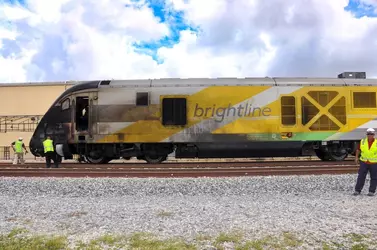
A Brightline train was charred after a fiery crash in Oakland Park in September 2019. Broward Sheriff's Office
Despite the corridor’s deadly history, Brightline spent years disputing the need for safety upgrades and downplaying warnings from local governments and regulators, reporters found.
Frank Frey, a Federal Railroad Administration engineer, was part of a team of regulators and railroad officials who walked the Brightline route in 2014 during a federal review process. In a subsequent report, Frey warned that trespassing across the tracks had reached “epidemic” proportions.
he called on the company to add crossing-gate arms and median dividers north of West Palm Beach to deter drivers from going around gates where trains would exceed 80 mph. Brightline resisted.
“[T]hey are not exercising appropriate safety practices and reasonable care,” Frey wrote in the report.
After Frey’s report became public, and amid pressure from Martin and Indian River counties, FDOT — the agency responsible for rail safety in Florida — said it would require Brightline to follow the federal guidance.
But those safety measures only applied to the 110-mph span of track that opened in late 2023 north of West Palm Beach. Crossing upgrades were less common in the South Florida counties (Palm Beach, Broward and Miami-Dade), where most of the deaths occur.
About 100 crossings have just two gate arms, one on each side of the tracks, which means drivers can still veer into the wrong lane to drive across. Brightline officials say the remaining 69% of the 331 crossings have four gate arms, and some have median dividers to keep people from driving into the other lane.
State bills introduced in 2017, 2018 and 2020 would have expanded FDOT’s authority to regulate Brightline, and would have required the rail company to pay for fencing at popular trespassing shortcuts and for safety equipment at crossings. Brightline opposed the bills — and each time, the legislation died without reaching a floor vote.
Brightline argued that the bills improperly targeted the company and weren’t needed.
The company was arguing against stricter fencing requirements. Rusty Roberts, then a Brightline official, said it was ineffective, expensive and difficult to maintain. Brightline officials recently told reporters that fencing that the company installed near the Aventura station has been knocked down three times.
But in 2022, when a federal grant offering millions of dollars for fencing became available, Brightline was on board. FDOT submitted an application, with Brightline’s support.
Now, company officials say fencing, though not a “cure-all,” is a good idea. Lefevre, the vice president of operations, recently called it “common sense” and said it would have an “immediate impact.”
“When done in the right area and with the proper length, fencing can be a benefit to channel pedestrians to the nearest crossing,” Lefevre said in a statement.
Under terms of the grant, Brightline will spend $10 million on safeguards, while federal and state governments will spend $35 million. That will pay for 33 miles of protective fencing and landscaping along the tracks, warning markings at crossings, and 168 crisis-support signs for people who are suicidal.
In the 33 months before the funding was released, 101 people died.
The U.S. Department of Transportation blamed the delay on a “grant backlog” from the Biden administration. In a statement to the Herald/WLRN, spokesman Nate Sizemore said the Federal Railroad Administration “has worked to hold Brightline ... accountable to the highest standards.” He said drivers and trespassing pedestrians were “the direct cause” of all of Brightline’s fatalities.
“We will continue to closely review any safety incident with Brightline and work with the railroad to prevent future occurrences,” Sizemore said.
Brightline declined to provide information to the Herald/WLRN on exactly how much of the nearly 200-mile route between Miami and Cocoa is currently protected by fencing, vegetation or other barriers. The tracks are easily accessible in most of South Florida.
In April, reporters visited the stretch of track where Maddie Brunelle died eight years ago in Boca Raton. It was still unfenced.
Maddie was an artist, an A student who had been admitted to college. But she was in a personal crisis. That afternoon in 2017, she walked out of a recovery center in Boca Raton, and, just a few blocks away, saw the open tracks.
Her mother, Amy, told reporters that getting to the tracks was too easy. Suicide can be an impulsive act, she noted, and the Brightline train runs past communities of “vulnerable” people.
According to FDOT, the FEC/Brightline tracks are surrounded by “disadvantaged communities” and “areas of persistent poverty.”
“What scares me is how much open track there is,” Brunelle said, “and how close it is to public areas.”
Experts say barriers and other measures can help. At San Francisco’s Golden Gate and Tampa’s Sunshine Skyway bridges, safety netting, fencing, signs and emergency call boxes have curbed suicides.
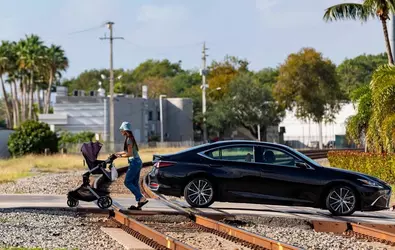
A woman and her daughter cross over train tracks that intersect Northeast 141st Street near Biscayne Boulevard on Wednesday, April 2, 2025, in North Miami, Fla. Matias J. Ocner mocner@miamiherald.com
’Should be permanently closed!’
As she inched her Honda forward at a railroad crossing in North Miami in March 2023, a young mother made a terrible mistake. Traffic wasn’t moving. The gates came down in front of her, and she was stuck on the tracks. A Brightline train was coming.The 28-year-old had only seconds to decide what to do. She flung the door open, grabbed her 2-year-old son out of the back seat, left the car that she had just bought that day, and ran.
The train slammed into her car 42 seconds later.
The crossing at 141st Street and U.S. 1 is one of the most dangerous along the Brightline route. At least seven times, Brightline trains have crashed into cars, mostly after drivers have scrambled to exit before impact.
Officials have discussed closing the crossing to traffic for years, so cars would no longer be able to drive across the tracks. In a 2023 email, Frey, the federal rail official, said regulators “pleaded with City officials to close this, but sadly the City declined.”
“There is absolutely no reason why this crossing should exist,” Frey wrote. “It should be permanently closed!”
The 141st Street crossing is one of nearly two dozen that regulators recommended for closure more than 10 years ago. All of them remain open today.
Cellphone video from an August 2022 incident in which no one was hurt captured one of the many collisions at the 141st Street crossing in North Miami.
The crossing’s location and lack of certain safety measures help explain the repeated collisions.
East of the crossing is U.S. 1, a major north-south highway that runs along Florida’s east coast just feet away from the Brightline tracks.
Vehicles have little space to line up. In multiple collisions, a backup of cars waiting to make a right onto U.S. 1 has turned drivers into “sitting ducks,” according to a federal rail safety official.
There is no sidewalk to guide pedestrians across the tracks. Instead, as the Florida Department of Transportation noted in a 2021 study, “the area between the roadway and the tracks is crushed gravel with no clear delineation of the railroad corridor.”
The area near the crossing is unfenced, giving pedestrians easy access to the tracks. The 2021 FDOT study recommends four-foot-high aluminum fencing near the tracks.
A key reason the Brightline corridor is so dangerous, reporters found, is the prevalence of crossings and local officials’ resistance to closing them.
“There are things that could be done to reduce the number of crossings and therefore the number of interactions between the railroad and the public,” Brightline’s Lefevre said. “It is not for lack of effort or interest on Brightline’s part that those things aren’t being done.”
Amit Bose, who led the Federal Railroad Administration under then-President Joe Biden, said in a recent interview that he walked some of the Brightline corridor and “couldn’t believe the number of grade crossings.”
“I knew the numbers, but just seeing it for myself, and seeing it, you know, every quarter-mile, half-mile continuously in these populated areas,” he said, “it definitely made my antenna go up.”
In other states, railroads and governments have invested billions of dollars in fencing, upgraded crossings, pedestrian bridges and other projects to prevent cars and people from accessing train tracks.
In Florida, where three passenger railroads rank among the deadliest in the country, even basic safeguards such as sounding a horn have not been deployed.
Normally, trains are required to blow their horns in a standardized pattern — two long blasts, one short blast and another long blast — as they approach crossings. Before approving communities to become quiet zones, federal regulators require them to add safety equipment to account for the danger of keeping horns silent.
In 2023, the Federal Railroad Administration took the rare step of reviewing Broward County’s quiet zone amid a spike in deaths at Brightline crossings.
Among those who had been killed was a homeless man who had just been handed a $1 bill in an area of open track not far from a “No Train Horn” sign in Pompano Beach. The man who gave it to him turned back a moment later to see him flying through the air. The $1 bill floated to the ground.
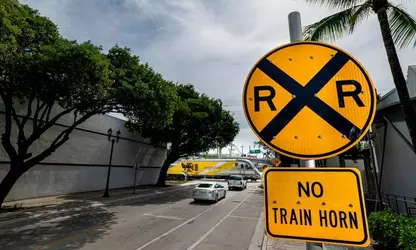
A ‘No Train Horn’ sign alerts drivers and pedestrians as a Brightline train crosses through Northwest 14th Street near Northwest 1st Avenue on Wednesday, July 9, 2025, in Miami, Fla. Matias J. Ocner mocner@miamiherald.com
The federal agency determined that Broward could keep its quiet zone if additional safety measures were taken and awarded a $15 million grant to upgrade 21 crossings throughout the county. That was two years ago; the grant agreement was signed in May.
The Florida transportation department has done little to address Brightline’s safety record. Jared Perdue, the agency’s director since 2022, declined repeated interview requests.
In response to detailed written questions, an agency spokesperson offered a general statement that blamed the public.
“Data shows that the leading cause of rail-related fatalities at railroad crossings in the U.S. is human behavior and this shows true in Florida statistics as well,” said the spokesperson, Michael Williams.
FDOT has invested nearly $180 million over the past decade to “enhance the safety of rail crossings around the state,” Williams said. The funding included a $60 million initiative to paint white Xs known as “dynamic envelopes” at the approach to each crossing.
Williams did not respond to repeated requests for a list of completed projects.
Florida Gov. Ron DeSantis, who expressed concern in 2019 over Brightline’s death toll, did not respond to reporters’ requests for comment.
A band played at the funeral of Amelise Renoir Noel, 60, at the Bethlehem Haitian Baptist Church on Jan. 11, 2025. Noel was hit by a Brightline train in Palm Beach County in December. Bethlehem Haitian Baptist Church
Death on the tracks
The day after Christmas, a Brightline train loaded with 236 passengers was rolling north from Miami to Orlando when a woman in gray braids stepped onto the tracks.Amelise Renoir Noel was walking home from her job at a catering company.
The horn sounded, but Noel stumbled. She couldn’t get out of the way.
Inside the train cab, the crew members knew they wouldn’t be able to stop in time. There wasn’t even time to pull the emergency brake, the conductor told investigators.
Brightline reported to federal regulators that the crew had “observed a trespasser standing, fouling their track.”
Noel’s death, ruled an accident, threw many into mourning. Friends, co-workers and family packed every pew at the Bethlehem Haitian Baptist Church for her funeral. It spanned two and a half hours. A brass band marched up the aisle.
Noel was 60 but seemed more like a 20-year-old, said her daughter-in-law, Elmide Dictant. For years, she had walked that route to and from work, across the tracks. Though it was technically trespassing, Noel would have had to walk out of her way to reach an official crossing. Her home was minutes from the tracks in Lake Park in northern Palm Beach County.
A wife, mother and grandmother, Noel “loved dancing,” Dictant remembered. “She loved making jokes, she loved to cook and loved making Haitian snacks.”
Noel’s death was the third in a two-year span for the young conductor in the train cab. None of them were her fault. The first time, she was so “in shock” she couldn’t tell police what happened, according to a report. Three months later, it happened again. A woman was walking between the tracks with her head down. Then, Noel’s death.
In March, she was in the locomotive cab when the train hit a fourth person, a thin, young man homesick for Ecuador.
He held his arms out, a deputy wrote, “as if he was welcoming the train to strike him.”
After each of the 182 deadly strikes, a similar scene unfolds.
The train stops. A crowd of officials descends on the tracks. Investigators pick through the gravel, collecting remnants of a life lost: A pinky finger, a zippered bag that says “fabulous,” a wedding ring. A head, a heart, a pair of jeans.
Engineers emerge to see that the front of the train is dented. Once, the train impaled a couple’s pickup truck, pinning them against the train’s nose.
Investigators’ records chronicle the collateral damage. Loved ones show up. A witness “with red and watery eyes” has to compose himself to tell officers what he saw. A boyfriend rides up on a bicycle and begins “sobbing uncontrollably.”
Eventually, a body-removal company collects what’s beneath the tarp.
Inside the train, where commuters are in a hurry to get somewhere, the shades are drawn down.
Will Mann, a Brightline passenger during a March fatality in Palm Beach County, told reporters that free potato chips and water were distributed while riders sat for three hours waiting, wondering. They couldn’t see outside.
They were told there had been an “incident,” he said, involving a “trespasser.” They got no further details.
The train had struck a woman, Christy Mateluna, who died at a hospital in West Palm Beach.
After her body was removed and the train finally got going, Mann said, passengers around him started clapping.
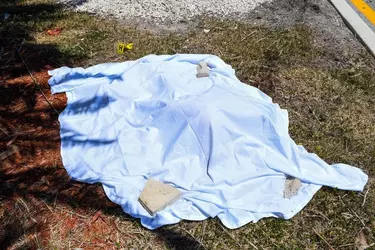
A sheet covers the body of Randy Johanson, the 131st fatality for Brightline. Johanson was disabled and living a simple life after a fall from a roofing job when he was 24 years old. The train was traveling at more than 100 miles an hour when it struck him. Brevard County Sheriff’s Office
Anyone who is experiencing suicidal thoughts should contact the National Suicide Prevention Lifeline (98or Crisis Text Line (text “HELLO” to 741741) for immediate support. Regular check-ins with primary care physicians and clergy members, who often have insights into community resources, can also be beneficial.
How the Miami Herald and WLRN found Brightline’s death toll
A team of reporters from the Miami Herald and WLRN spent over a year documenting every death involving Brightline trains since the rail line’s launch seven years ago. Drawing on autopsy reports and local law enforcement records, reporters discovered that 182 people — so far — have been killed by the fast-speed train.The team of reporters analyzed federal railroad data, reviewed federal safety studies, consulted experts and reviewed hundreds of pages of medical examiner and police incident reports to better understand the factors that contributed to each death and to compare Brightline’s safety record against other railroads nationwide.
Read the full methodology here.
Credits
Brittany Wallman | Investigative ReporterAaron Leibowitz | Local Government Reporter
Daniel Rivero | Investigative Reporter, WLRN
Joshua Ceballos | Local Government Accountability Reporter, WLRN
Shradha Dinesh | Data Journalist
Allison Beck | Intern, Ida B. Wells Society
Susan Merriam | Data/Visual Journalist
David Newcomb | Director of Editorial Project Experiences
Sohail Al-Jamea | 3-D Modeling, Animation and Video Journalist
Rachel Handley | Visual Journalist
Matias J. Ocner | Photographer
David Santiago | Photo Editor
John Parkhurst | Copy Editor
Carolina Zamora | Audience & Engagement
Jessica Bakeman | Director of Enterprise Journalism, WLRN
Jessica Lipscomb | City Editor
Trish Wilson Belli | Investigations Editor
Support
The Fund for Investigative Journalism provided support for this series.Source (Archive)